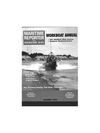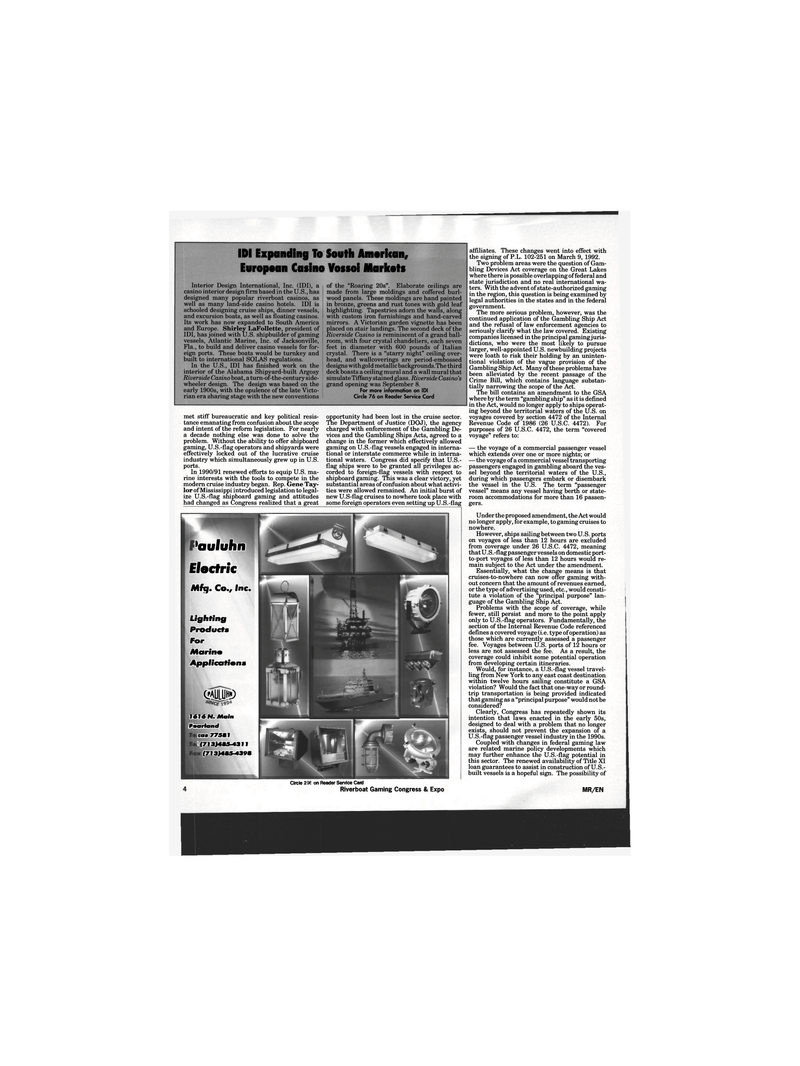
Page 20: of Maritime Reporter Magazine (October 1994)
Read this page in Pdf, Flash or Html5 edition of October 1994 Maritime Reporter Magazine
IDI Expanding To South American,
European Casino Vossoi Markets
Interior Design International, Inc. (IDI), a casino interior design firm based in the U.S., has designed many popular riverboat casinos, as well as many land-side casino hotels. IDI is schooled designing cruise ships, dinner vessels, and excursion boats, as well as floating casinos.
Its work has now expanded to South America and Europe. Shirley LaFoIlette, president of
IDI, has joined with U.S. shipbuilder of gaming vessels, Atlantic Marine, Inc. of Jacksonville,
Fla., to build and deliver casino vessels for for- eign ports. These boats would be turnkey and built to international SOLAS regulations.
In the U.S., IDI has finished work on the interior of the Alabama Shipyard-built Argosy
Riverside Casino boat, a turn-of-the-century side- wheeler design. The design was based on the early 1900s, with the opulence of the late Victo- rian era sharing stage with the new conventions of the "Roaring 20s". Elaborate ceilings are made from large moldings and coffered burl- wood panels. These moldings are hand painted in bronze, greens and rust tones with gold leaf highlighting. Tapestries adorn the walls, along with custom iron furnishings and hand-carved mirrors. A Victorian garden vignette has been placed on stair landings. The second deck of the
Riverside Casino is reminiscent of a grand ball- room, with four crystal chandeliers, each seven feet in diameter with 600 pounds of Italian crystal. There is a "starry night" ceiling over- head, and wallcoverings are period-embossed designs with gold metallic backgrounds.The third deck boasts a ceiling mural and a wall mural that simulate Tiffany stained glass. Riverside Casino's grand opening was September 8.
For more information on IDI
Circle 76 on Reader Service Card met stiff bureaucratic and key political resis- tance emanating from confusion about the scope and intent of the reform legislation. For nearly a decade nothing else was done to solve the problem. Without the ability to offer shipboard gaming, U.S.-flag operators and shipyards were effectively locked out of the lucrative cruise industry which simultaneously grew up in U.S. ports.
In 1990/91 renewed efforts to equip U.S. ma- rine interests with the tools to compete in the modern cruise industry began. Rep. Gene Tay- lor of Mississippi introduced legislation to legal- ize U.S.-flag shipboard gaming and attitudes had changed as Congress realized that a great opportunity had been lost in the cruise sector.
The Department of Justice (DOJ), the agency charged with enforcement of the Gambling De- vices and the Gambling Ships Acts, agreed to a change in the former which effectively allowed gaming on U.S.-flag vessels engaged in interna- tional or interstate commerce while in interna- tional waters. Congress did specify that U.S.- flag ships were to be granted all privileges ac- corded to foreign-flag vessels with respect to shipboard gaming. This was a clear victory, yet substantial areas of confusion about what activi- ties were allowed remained. An initial burst of new U.S-flag cruises to nowhere took place with some foreign operators even setting up U.S.-flag affiliates. These changes went into effect with the signing of P.L. 102-251 on March 9, 1992.
Two problem areas were the question of Gam- bling Devices Act coverage on the Great Lakes where there is possible overlapping of federal and state jurisdiction and no real international wa- ters. With the advent of state-authorized gaming in the region, this question is being examined by legal authorities in the states and in the federal government.
The more serious problem, however, was the continued application of the Gambling Ship Act and the refusal of law enforcement agencies to seriously clarify what the law covered. Existing companies licensed in the principal gaming juris- dictions, who were the most likely to pursue larger, well-appointed U.S. newbuilding projects were loath to risk their holding by an uninten- tional violation of the vague provision of the
Gambling Ship Act. Many of these problems have been alleviated by the recent passage of the
Crime Bill, which contains language substan- tially narrowing the scope of the Act.
The bill contains an amendment to the GSA where by the term "gambling ship" as it is defined in the Act, would no longer apply to ships operat- ing beyond the territorial waters of the U.S. on voyages covered by section 4472 of the Internal
Revenue Code of 1986 (26 U.S.C. 4472). For purposes of 26 U.S.C. 4472, the term "covered voyage" refers to: — the voyage of a commercial passenger vessel which extends over one or more nights; or — the voyage of a commercial vessel transporting passengers engaged in gambling aboard the ves- sel beyond the territorial waters of the U.S., during which passengers embark or disembark the vessel in the U.S. The term "passenger vessel" means any vessel having berth or state- room accommodations for more than 16 passen- gers.
Under the proposed amendment, the Act would no longer apply, for example, to gaming cruises to nowhere.
However, ships sailing between two U.S. ports on voyages of less than 12 hours are excluded from coverage under 26 U.S.C. 4472, meaning that U.S.-flag passenger vessels on domestic port- to-port voyages of less than 12 hours would re- main subject to the Act under the amendment.
Essentially, what the change means is that cruises-to-nowhere can now offer gaming with- out concern that the amount of revenues earned, or the type of advertising used, etc., would consti- tute a violation of the "principal purpose" lan- guage of the Gambling Ship Act.
Problems with the scope of coverage, while fewer, still persist and more to the point apply only to U.S.-flag operators. Fundamentally, the section of the Internal Revenue Code referenced defines a covered voyage (i.e. type of operation) as those which are currently assessed a passenger fee. Voyages between U.S. ports of 12 hours or less are not assessed the fee. As a result, the coverage could inhibit some potential operation from developing certain itineraries.
Would, for instance, a U.S.-flag vessel travel- ling from New York to any east coast destination within twelve hours sailing constitute a GSA violation? Would the fact that one-way or round- trip transportation is being provided indicated that gaming as a "principal purpose" would not be considered?
Clearly, Congress has repeatedly shown its intention that laws enacted in the early 50s, designed to deal with a problem that no longer exists, should not prevent the expansion of a
U.S.-flag passenger vessel industry in the 1990s.
Coupled with changes in federal gaming law are related marine policy developments which may further enhance the U.S.-flag potential in this sector. The renewed availability of Title XI loan guarantees to assist in construction of U.S.- built vessels is a hopeful sign. The possibility of
MR/EN >auluhn
Electric
Mftjm Co., Inc*
Lighting
Products
For
Marino
Applications
QAULUH!) 1616 N. Main
Poarland tarn 77581 1 (713)485-4311 (713)485-4398
Circle 234 on Reader Service Card
Riverboat Gaming Congress & Expo 13

 19
19

 21
21
